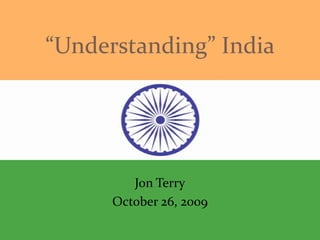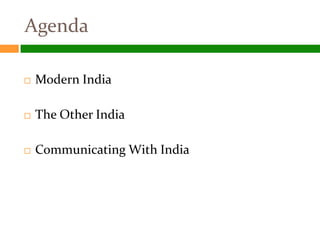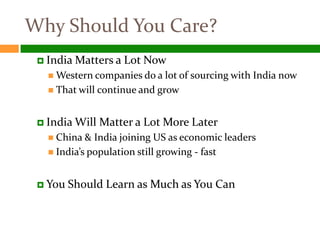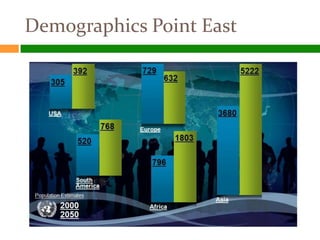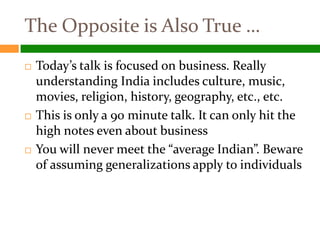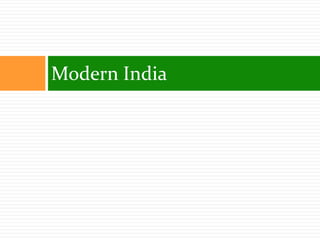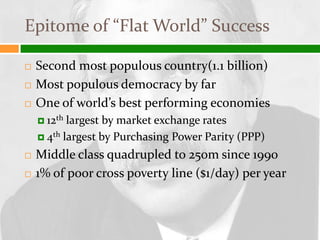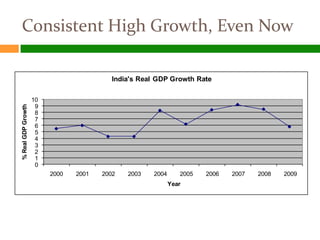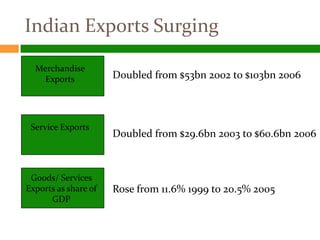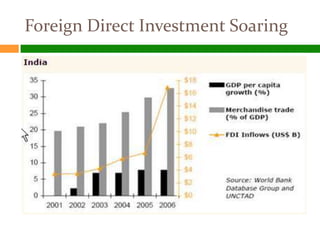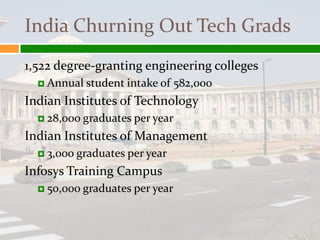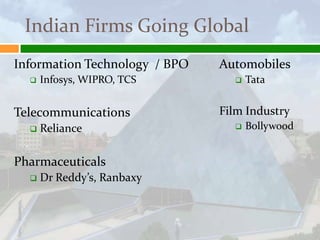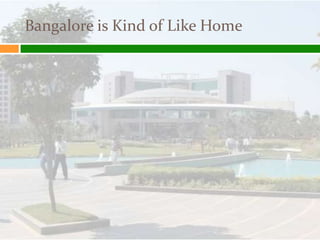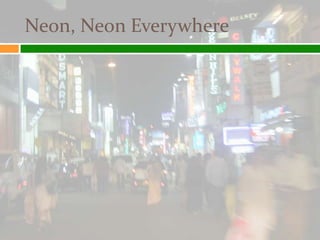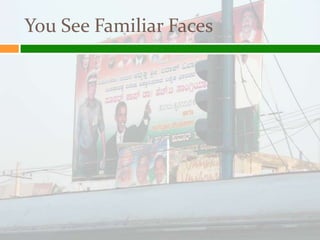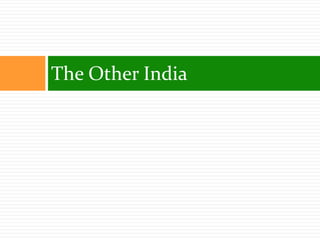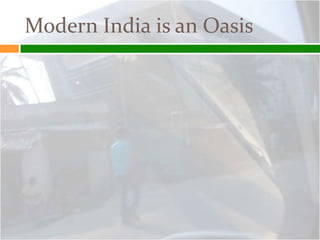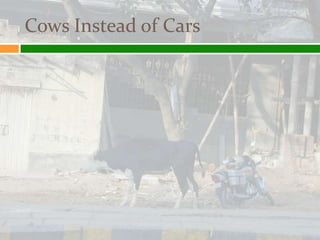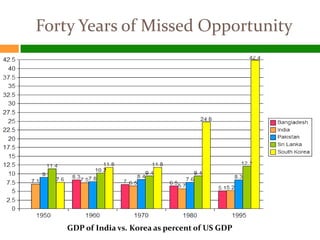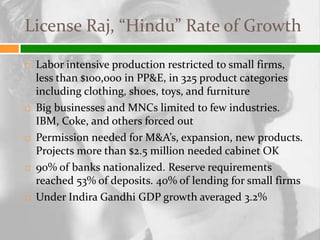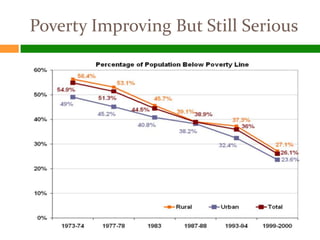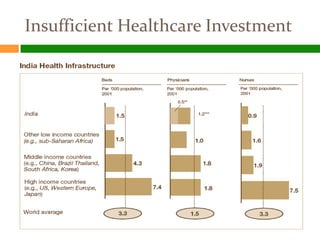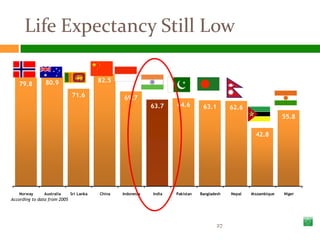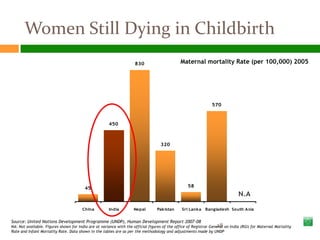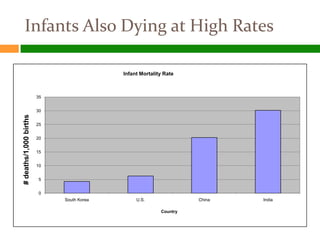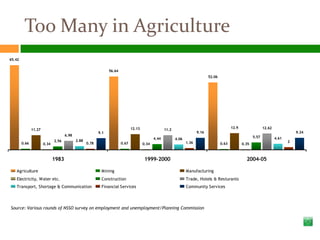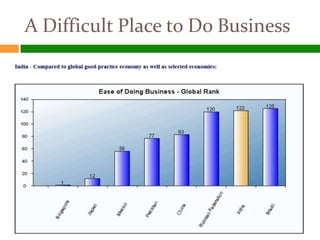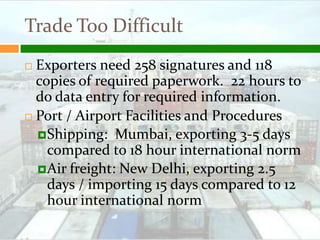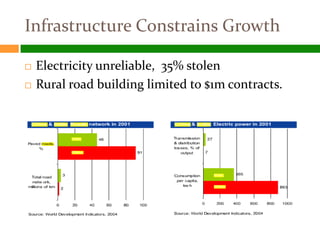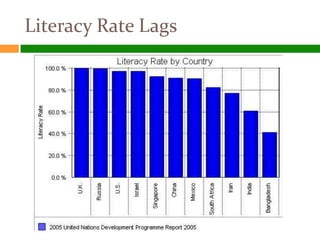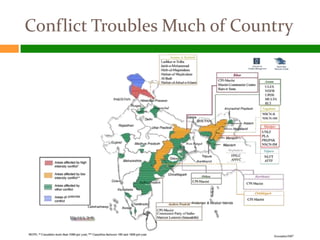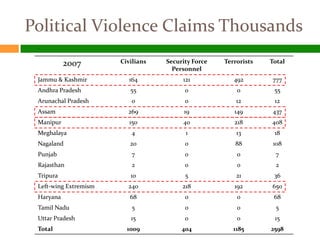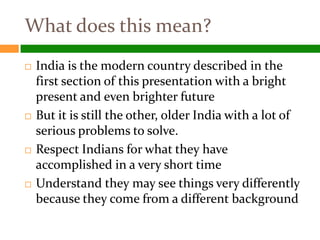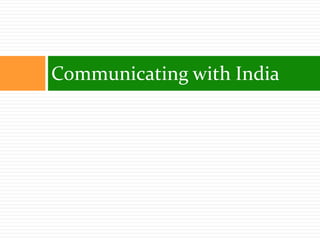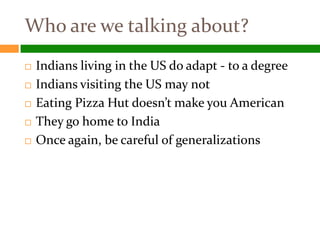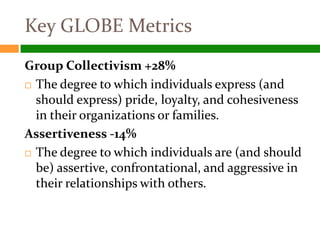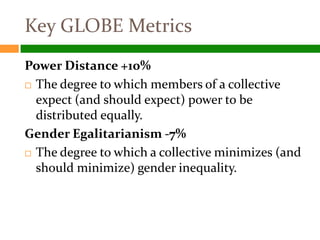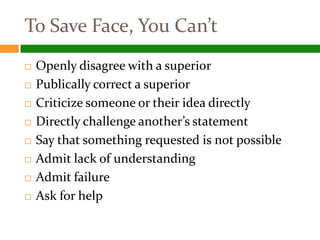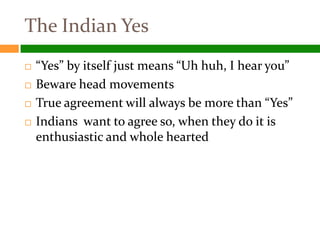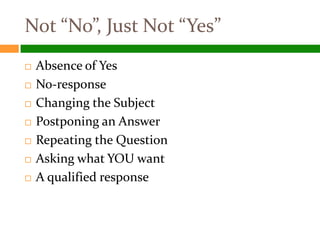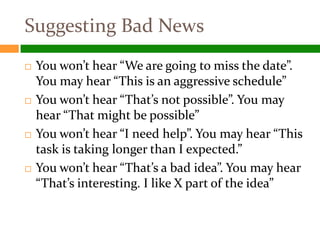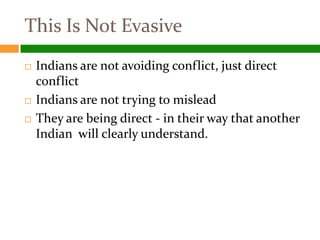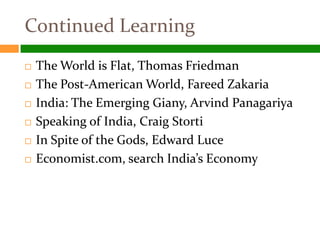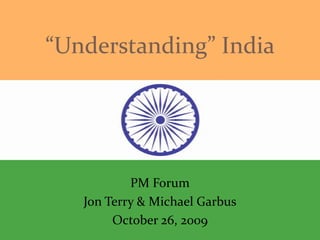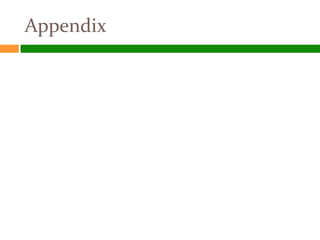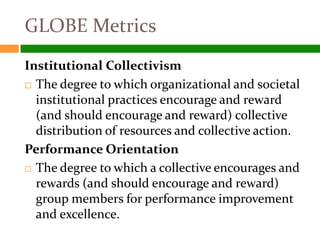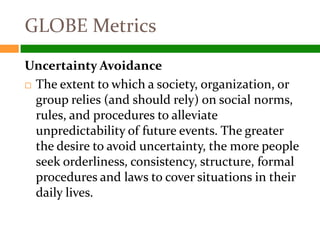Understanding India
- 1. “Understanding” India Jon Terry October 26, 2009
- 2. Agenda Modern India The Other India Communicating With India
- 3. Why Should You Care? India Matters a Lot Now Western companies do a lot of sourcing with India now That will continue and grow India Will Matter a Lot More Later China & India joining US as economic leaders India’s population still growing - fast You Should Learn as Much as You Can
- 5. The Opposite is Also True … Today’s talk is focused on business. Really understanding India includes culture, music, movies, religion, history, geography, etc., etc. This is only a 90 minute talk. It can only hit the high notes even about business You will never meet the “average Indian”. Beware of assuming generalizations apply to individuals
- 6. Modern India
- 7. Epitome of “Flat World” Success Second most populous country(1.1 billion) Most populous democracy by far One of world’s best performing economies 12th largest by market exchange rates 4th largest by Purchasing Power Parity (PPP) Middle class quadrupled to 250m since 1990 1% of poor cross poverty line ($1/day) per year
- 8. Consistent High Growth, Even Now India's Real GDP Growth Rate 10 9 % Real GDP Growth 8 7 6 5 4 3 2 1 0 2000 2001 2002 2003 2004 2005 2006 2007 2008 2009 Year
- 9. Joining the US and China at the Top
- 10. Indian Exports Surging Merchandise Exports Doubled from $53bn 2002 to $103bn 2006 Service Exports Doubled from $29.6bn 2003 to $60.6bn 2006 Goods/ Services Exports as share of Rose from 11.6% 1999 to 20.5% 2005 GDP
- 11. Foreign Direct Investment Soaring
- 12. India Churning Out Tech Grads 1,522 degree-granting engineering colleges Annual student intake of 582,000 Indian Institutes of Technology 28,000 graduates per year Indian Institutes of Management 3,000 graduates per year Infosys Training Campus 50,000 graduates per year
- 13. Indian Firms Going Global Information Technology / BPO Automobiles Infosys, WIPRO, TCS Tata Telecommunications Film Industry Reliance Bollywood Pharmaceuticals Dr Reddy’s, Ranbaxy
- 14. World Coming to India for Care 450,000 Medical Tourists came to India in 2007 Projected value of $2 billion by 2012 Very High Quality at Very Low Prices Heart bypass in US $95,000, in India $10,000 including airfare, hotel, and treatment Apollo, Fortis, Max, Wockhardt building US quality hospitals co-branded by Harvard, Johns Hopkins Narayana Hrudayalaya 1,000bed heart hospital, 50-60 surgeries/day Telemed links to 54 sites in India, SW Asia, & Africa
- 15. Bangalore is Kind of Like Home
- 17. You See Familiar Faces
- 18. Are They Learning About US?
- 19. The Other India
- 20. Most Indians Still Poor 4th Largest Economy, but 168th GDP per capita
- 21. Modern India is an Oasis
- 22. Cows Instead of Cars
- 23. Forty Years of Missed Opportunity GDP of India vs. Korea as percent of US GDP
- 24. License Raj, “Hindu” Rate of Growth Labor intensive production restricted to small firms, less than $100,000 in PP&E, in 325 product categories including clothing, shoes, toys, and furniture Big businesses and MNCs limited to few industries. IBM, Coke, and others forced out Permission needed for M&A’s, expansion, new products. Projects more than $2.5 million needed cabinet OK 90% of banks nationalized. Reserve requirements reached 53% of deposits. 40% of lending for small firms Under Indira Gandhi GDP growth averaged 3.2%
- 25. Poverty Improving But Still Serious
- 27. Life Expectancy Still Low 80.9 82.5 79.8 71.6 69.7 63.7 64.6 63.1 62.6 55.8 42.8 Norway Australia Sri Lanka China Indonesia India Pakistan Bangladesh Nepal Mozambique Niger According to data from 2005 27
- 28. Women Still Dying in Childbirth 830 Maternal mortality Rate (per 100,000) 2005 570 450 320 45 58 N.A China India Nepal Pakistan Sri Lanka Bangladesh South Asia Source: United Nations Development Programme (UNDP), Human Development Report 2007-08 28 NA: Not available. Figures shown for India are at variance with the official figures of the office of Registrar General on India (RGI) for Maternal Mortality Rate and Infant Mortality Rate. Data shown in the tables are as per the methodology and adjustments made by UNDP
- 29. Infants Also Dying at High Rates Infant Mortality Rate 35 30 # deaths/1,000 births 25 20 15 10 5 0 South Korea U.S. China India Country
- 30. Too Many in Agriculture 65.42 56.64 52.06 12.13 12.9 12.62 11.27 11.2 9.1 9.16 9.24 6.98 5.57 4.44 4.06 4.61 2.56 2.88 2 0.66 0.34 0.78 0.67 0.34 1.36 0.63 0.35 1983 1999-2000 2004-05 Agriculture Mining Manufacturing Electricity, Water etc. Construction Trade, Hotels & Resturants Transport, Shortage & Communication Financial Services Community Services Source: Various rounds of NSSO survey on employment and unemployment/Planning Commission
- 31. A Difficult Place to Do Business
- 32. Labor Laws Keep Firms Inefficient Firms over 100 workers can’t layoff even under bankruptcy 3 weeks written notice to change any working conditions Laws apply to only 10% of the workforce, yet discourages hiring new workers. Keeps companies small – of 42m companies only 1.4% employ more than 10 people. 88% of labor force informal sector: produces only 44% of GDP
- 33. Trade Too Difficult Exporters need 258 signatures and 118 copies of required paperwork. 22 hours to do data entry for required information. Port / Airport Facilities and Procedures Shipping: Mumbai, exporting 3-5 days compared to 18 hour international norm Air freight: New Delhi, exporting 2.5 days / importing 15 days compared to 12 hour international norm
- 34. Infrastructure Constrains Growth Electricity unreliable, 35% stolen Rural road building limited to $1m contracts.
- 36. Conflict Troubles Much of Country
- 37. Political Violence Claims Thousands 2007 Civilians Security Force Terrorists Total Personnel Jammu & Kashmir 164 121 492 777 Andhra Pradesh 55 0 0 55 Arunachal Pradesh 0 0 12 12 Assam 269 19 149 437 Manipur 150 40 218 408 Meghalaya 4 1 13 18 Nagaland 20 0 88 108 Punjab 7 0 0 7 Rajasthan 2 0 0 2 Tripura 10 5 21 36 Left-wing Extremism 240 218 192 650 Haryana 68 0 0 68 Tamil Nadu 5 0 0 5 Uttar Pradesh 15 0 0 15 Total 1009 404 1185 2598
- 38. What does this mean? India is the modern country described in the first section of this presentation with a bright present and even brighter future But it is still the other, older India with a lot of serious problems to solve. Respect Indians for what they have accomplished in a very short time Understand they may see things very differently because they come from a different background
- 40. Who are we talking about? Indians living in the US do adapt - to a degree Indians visiting the US may not Eating Pizza Hut doesn’t make you American They go home to India Once again, be careful of generalizations
- 41. Measuring Cultural Differences The GLOBE survey Scientifically-designed, controlled survey 10 years 17,000 managers Asked to describe their company culture 62 societal cultures Including India and the US
- 42. Comparing US & Indian Culture Institutional Collectivism 6 5 Humane Orientation Group Collectivism 4 3 2 Uncertainty Avoidance 1 Gender Egalitarianism 0 Future Orientation Assertiveness US India Performance Orientation Power Distance
- 43. Key GLOBE Metrics Group Collectivism +28% The degree to which individuals express (and should express) pride, loyalty, and cohesiveness in their organizations or families. Assertiveness -14% The degree to which individuals are (and should be) assertive, confrontational, and aggressive in their relationships with others.
- 44. Key GLOBE Metrics Power Distance +10% The degree to which members of a collective expect (and should expect) power to be distributed equally. Gender Egalitarianism -7% The degree to which a collective minimizes (and should minimize) gender inequality.
- 45. To Save Face, You Can’t Openly disagree with a superior Publically correct a superior Criticize someone or their idea directly Directly challenge another’s statement Say that something requested is not possible Admit lack of understanding Admit failure Ask for help
- 46. The Indian Yes “Yes” by itself just means “Uh huh, I hear you” Beware head movements True agreement will always be more than “Yes” Indians want to agree so, when they do it is enthusiastic and whole hearted
- 47. Not “No”, Just Not “Yes” Absence of Yes No-response Changing the Subject Postponing an Answer Repeating the Question Asking what YOU want A qualified response
- 48. Suggesting Bad News You won’t hear “We are going to miss the date”. You may hear “This is an aggressive schedule” You won’t hear “That’s not possible”. You may hear “That might be possible” You won’t hear “I need help”. You may hear “This task is taking longer than I expected.” You won’t hear “That’s a bad idea”. You may hear “That’s interesting. I like X part of the idea”
- 49. This Is Not Evasive Indians are not avoiding conflict, just direct conflict Indians are not trying to mislead They are being direct - in their way that another Indian will clearly understand.
- 50. What Can You Do? Be sure you REALLY got agreement Listen for subtle implications of difficulty Find ways to ask for feedback privately Consider suggesting your own concerns or questions to elicit theirs Keep learning to increase understanding
- 51. Continued Learning The World is Flat, Thomas Friedman The Post-American World, Fareed Zakaria India: The Emerging Giany, Arvind Panagariya Speaking of India, Craig Storti In Spite of the Gods, Edward Luce Economist.com, search India’s Economy
- 52. “Understanding” India PM Forum Jon Terry & Michael Garbus October 26, 2009
- 53. Appendix
- 54. GLOBE Metrics Future Orientation The extent to which individuals engage (and should engage) in future-oriented behaviors such as delaying gratification, planning, and investing in the future. Humane Orientation The degree to which a collective encourages and rewards ( and should encourage and reward) individuals for being fair, altruistic, generous, caring, and kind to others.
- 55. GLOBE Metrics Institutional Collectivism The degree to which organizational and societal institutional practices encourage and reward (and should encourage and reward) collective distribution of resources and collective action. Performance Orientation The degree to which a collective encourages and rewards (and should encourage and reward) group members for performance improvement and excellence.
- 56. GLOBE Metrics Uncertainty Avoidance The extent to which a society, organization, or group relies (and should rely) on social norms, rules, and procedures to alleviate unpredictability of future events. The greater the desire to avoid uncertainty, the more people seek orderliness, consistency, structure, formal procedures and laws to cover situations in their daily lives.
Editor's Notes
- #8: In 1990, India had 5 million phone lines in total. Today it adds 5 million per month.
- #9: By comparison, US grew only 1.1% in 2008 and is negative so far in 2009At this pace, national wealth doubles about every 10 years.
- #12: Back office of the world: If you are in IT, You are in IndiaCisco, Msft, Philips, IBM, GE HealthcareCisco has made Bangalore their second headquarters with half their executive staffIBM has 80,000 employees in India
- #13: Companies come to India for the highly-skilled, English speaking laborSlide background is one of the building on the Infosys campus. Many other giant training buildings
- #14: Tata bought both Landrover and Jag, Tata Nano (world’s cheapest real family car)Bollywood sold 3.6 billion tickets worldwide in 2005 versus 2.6 billion for Hollywood movies
- #26: Poverty means less than $1/dayPoverty rate in orissa and bihar >40%80% live on less than $2 per day = double
- #27: TB, malaria, polio, dengue, diarrhea, still major killers. Think about effect of the flu in the US.Absenteeism up to 40% among government healthcare workers
- #28: Poor access to health care, high childhood death rates still, high burden of infectious disease – diseases of povertyAmong the middle class and the wealthy, developing diseases of affluence: very high rates of cardiovascular mortality
- #30: 60m malnourished children – 40% of world’s total
- #31: 50% of population involved yet produces only 20% of GDPProfessional services 13% of GDP 1.2% of population employed
- #32: Highly corrupt
- #35: This is why every Indian IT campus has back-up power generation.
- #36: highly variable between states (Kerala 90% lit rate, Bihar 47%)Enrollment in secondary education 36%Of 19-24 year olds,only 9% in college – constraint on ability for IT industry to take on more work.Education funding below level of sub-saharanafrica.
- #38: Mumbai 2008

